Well, that IS the question.
A subject that is discussed again and again by violin makers, restorers and players. It comes down to personal preference, but often a player will choose an instrument to try based on its appearance (as well as budget!).
For makers copying is very common; heads, outlines, arching’s, thickness of plates, and has been synonymous with every maker since time began. It is how we learn and how we explore the instrument shape and sound.
But what has become more prevalent over the past 50 years is replicating the ‘look’ of a worn instrument. This was happening long before, but not to the same extent as more recently.
To work out how much wear instruments suffer, we must search for a shining example of purity. We need look no further than Oxford!
The most famous Antonio Stradivari instrument is a violin known as ‘Le Messie’ (The Messiah) which resides in the Ashmolean Museum. It was gifted by the well-known family ‘W.E. Hill and Sons’, dealers and makers since about 1883.
However this violin is so special that this offer was made under the strict proviso that it would never be played. This stipulation came about because of its’ near perfect condition, and offers us a clear insight into how these instruments looked when first made.
The reason the Messiah has retained its beautiful original varnish and striking unworn edges, virtually untouched, is because it has spent almost its entire life in the hands of dealers rather than players.
The Hill legacy preserves it as an example for all to see. I have viewed the violin many times and the wood and varnish is not worn or faded. I can imagine myself leaving Strads shop, having purchased it in 1716 and it resembling how I see it today. It looks new!
So, do you as a player accept that level of perfection in the making and the appearance, that toffee apple finish, in a brand new instrument with a brand new look? The varnish is vibrant, even and alive. The edges are crisp and the makers’ lines flow. Or do you feel more comfortable with a reproduced instrument? One where the varnish has been applied and then stripped back, scratched off, chipped away at. Corners and edge work softened or filed away.
This is carried out by a maker to resemble maybe a famous violin that has had 300 years worth of playing, to represent the consequences, replicating the wear and tear of its playing life.
How lucky we are today with such variety, the choices are endless. A new instrument that looks modern. A new instrument that looks old. An old instrument in mint condition. An old instrument with years of natural wear and restoration. And of course all those instruments in-between!
Ultimately as owner and player whichever you decide is right for you, I know you won’t judge the instrument on looks alone. Remain open to trying all. Once it’s in playing position you’ll forget its appearance……… and you’ll hear its voice.
And that’s the answer for me, right there. How you sound together, not how you look together!


Leave a comment